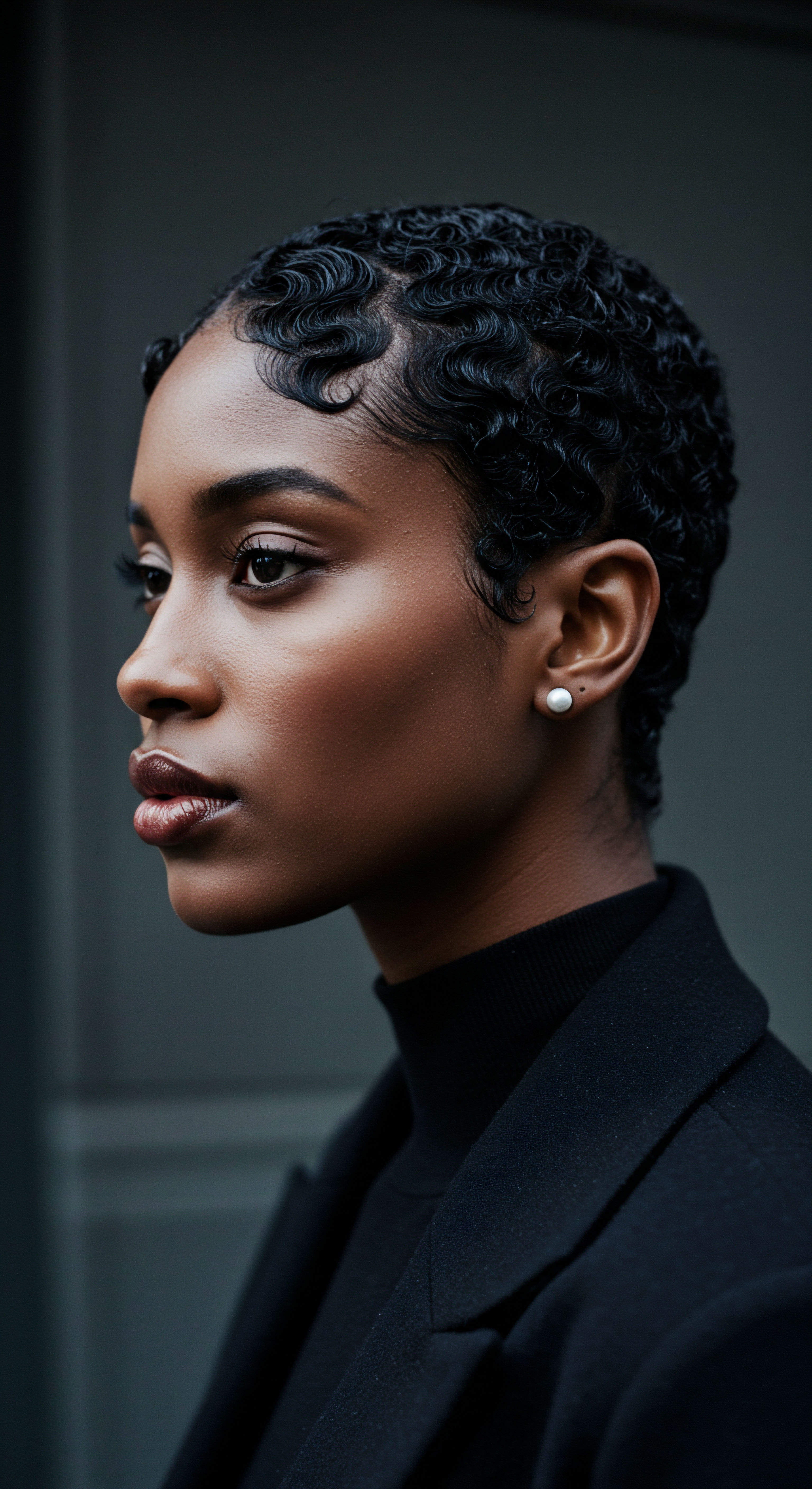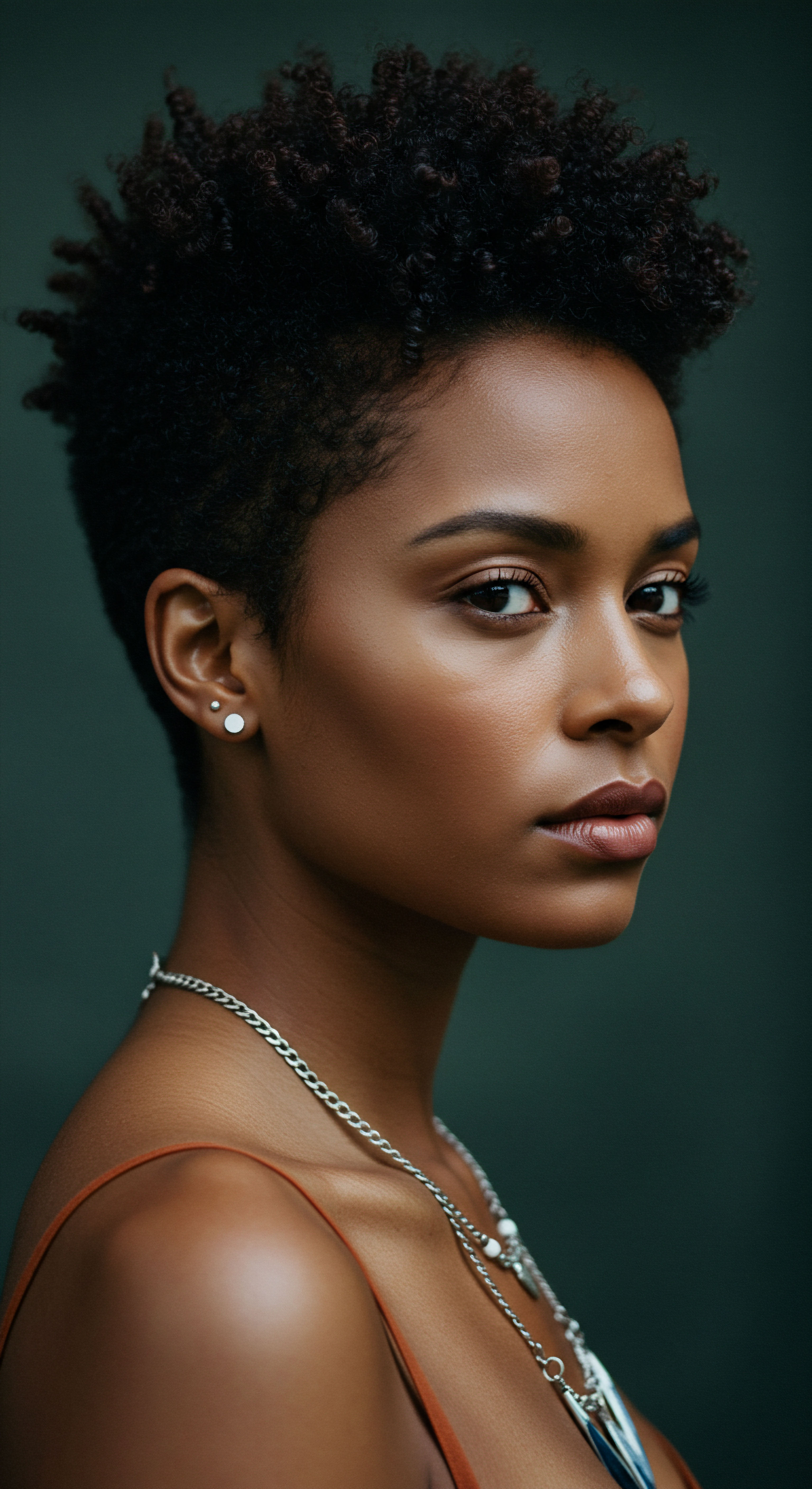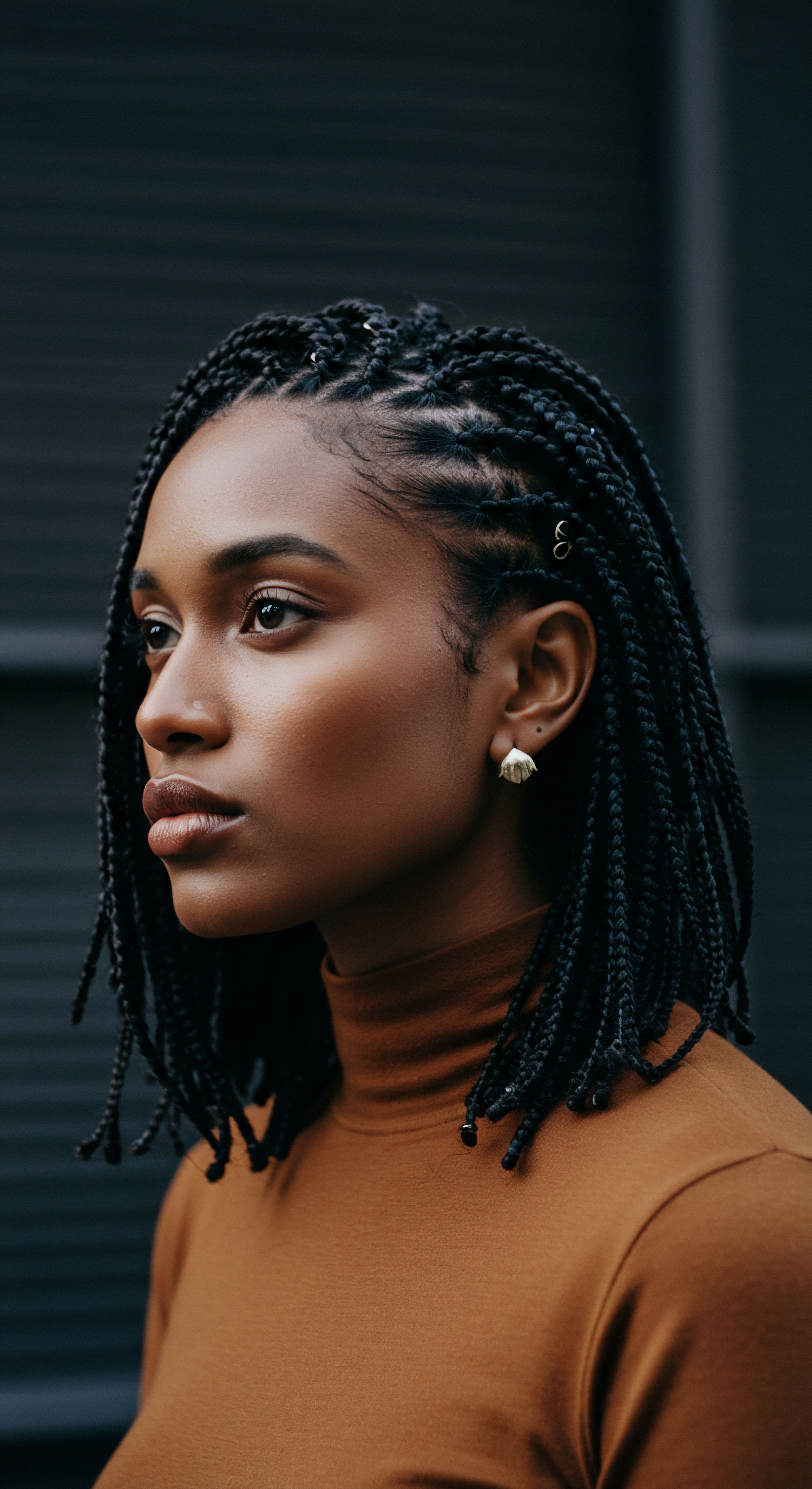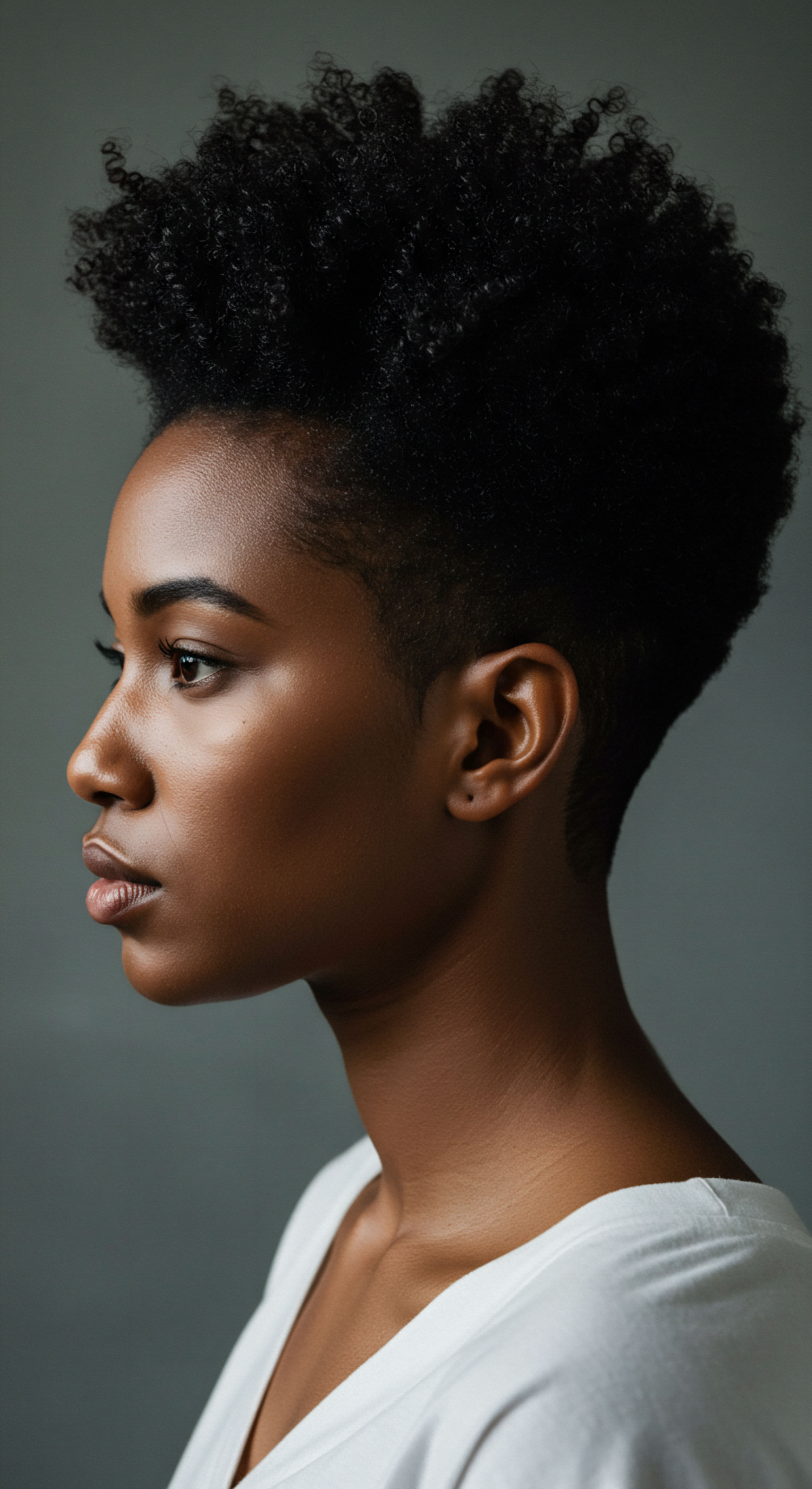
Roots
The story of healthy hair begins not at its visible ends, but beneath, at the very crown of our being—the scalp. For those whose strands coil and curve, whose hair holds the whispers of ancestry and diverse textures, the conversation around scalp care takes on a profound resonance. It is a dialogue about honoring traditions while embracing scientific understanding, about the unseen world that flourishes or falters beneath protective coverings. When textured hair finds solace in a bonnet, a scarf, or a wig, a unique microclimate forms.
This environment, a silent partner in our hair journeys, shapes the delicate balance of the scalp’s living surface. Our inquiry into the materials that best support this hidden ecosystem is a quest for comfort, for vitality, and for the enduring well-being of our crowning glory.

Understanding the Scalp’s Living Surface
The human scalp is far more than just skin; it represents a complex biological landscape. Home to approximately 100,000 to 150,000 hair follicles, it supports a diverse community of microorganisms—bacteria, fungi, and even mites—collectively known as the scalp microbiome. This intricate community plays a part in maintaining scalp health. When this balance is disrupted, often termed dysbiosis, it can lead to various scalp issues, including dryness, irritation, flaking, and even hair loss.
The scalp’s unique environment, characterized by moisture, warmth, and the presence of sebaceous glands, provides a hospitable setting for these microorganisms. Unlike other skin areas, hair follicles extend deeply into the dermis, creating secluded niches where microbes can reside. The pH of the scalp, ideally slightly acidic (around 4.5-5.5), also influences the microbial composition, serving as a natural barrier against certain pathogenic growths.
The scalp’s intricate microbial community thrives in a delicate balance, influencing overall hair health.

The Influence of Occlusion on Scalp Health
Textured hair often benefits from protective styles and coverings, which help reduce friction, retain moisture, and guard against environmental stressors. However, these coverings, while beneficial for the hair strands themselves, introduce an element of occlusion to the scalp. Occlusion refers to the act of covering the skin, which can significantly alter the local environment by reducing transepidermal water loss (TEWL) and increasing skin hydration. While increased hydration might seem positive, excessive accumulation of water in the stratum corneum (the outermost layer of the skin) can lead to increased permeability and potentially alter the scalp’s pH.
Studies have looked at the effects of head coverings on scalp conditions. For instance, research involving hijab-wearing women noted that while some complained of scalp problems such as itching and dandruff, a study on scalp hydration and pH values found no statistically significant difference between hijab-wearing and non-hijab-wearing women, provided the hijab was not worn in wet conditions. This suggests that the material and proper care of the covering are more significant than the mere act of covering itself.

Material Properties and Scalp Dynamics
The choice of material for hair coverings directly influences the microclimate created around the scalp. Different fibers possess distinct properties that determine their breathability, moisture handling, and surface texture, all of which impact the scalp microbiome.
- Breathability ❉ A material’s ability to allow air circulation is paramount. Poor breathability can trap heat and sweat, creating a warm, humid environment that can encourage the overgrowth of certain microbes, potentially leading to issues like folliculitis or fungal infections.
- Moisture Absorption and Wicking ❉ How a material handles moisture is critical. Some materials absorb moisture, drawing it away from the scalp, while others repel it, keeping the scalp environment more stable. An ideal material would manage sweat without stripping the scalp of its natural, beneficial oils.
- Surface Smoothness ❉ The texture of the material directly interacts with hair strands and the scalp. Rough textures can cause friction, leading to hair breakage and potential scalp irritation, which in turn can compromise the skin barrier and allow for microbial imbalance.

Ritual
Our daily routines, the quiet acts of self-care, hold more sway over our scalp’s well-being than we might initially perceive. For those who choose to cover their textured hair, whether for protection, style, or cultural expression, the selection of materials for these coverings becomes a mindful practice. This section offers a guiding hand through the practical considerations, examining how different fabrics interact with the scalp’s delicate ecosystem and how our choices can support a flourishing environment beneath our chosen coverings. We will delve into the qualities that make certain materials allies in scalp health, moving beyond simple recommendations to an understanding of why these choices matter for the sustained vitality of our hair.

Selecting Materials for Scalp Well-Being
When considering materials for textured hair coverings, the objective is to find fabrics that balance protection for the hair with an optimal environment for the scalp. This means seeking out properties that minimize friction, regulate temperature, and manage moisture effectively.
For instance, a significant clinical study compared silk bonnets to cotton head coverings over an eight-week period, finding that silk reduced hair breakage by 43%. This reduction is primarily due to silk’s inherent smoothness, which minimizes friction between hair strands and the fabric, thereby reducing mechanical stress on the hair and potentially the scalp.

How do Common Covering Materials Compare for Scalp Health?
Different materials present varying benefits and drawbacks for the scalp microbiome:
- Silk ❉ Revered for its smooth surface, silk causes minimal friction, reducing hair breakage and potential scalp irritation. Its natural protein structure allows for good air circulation and helps regulate temperature, preventing excessive heat buildup. Silk also retains hair’s natural moisture rather than absorbing it, which is especially beneficial for textured hair types that tend to lose moisture rapidly. Furthermore, pure silk is naturally resistant to dust mites and other allergens, making it a gentle option for sensitive scalps.
- Satin (Polyester-Based) ❉ While offering a smooth surface similar to silk, many satin fabrics are synthetic, often made from polyester. These can still reduce friction effectively, but their breathability and moisture-wicking properties may vary greatly depending on the specific weave and quality. Some synthetic fibers can trap heat and sweat, potentially creating a less desirable microclimate for the scalp if not properly managed. Low-quality synthetic materials, especially in hair extensions, have been linked to scalp irritation, itching, and allergic reactions due to chemical coatings or harsh ingredients.
- Cotton ❉ As a natural fiber, cotton is highly breathable and absorbent. This absorbency can be a double-edged sword; while it wicks away sweat, it can also absorb natural oils and moisture from the hair and scalp, potentially leading to dryness for some textured hair types. For scalp health, cotton’s breathability is a plus, but its friction-creating texture can be a concern for hair breakage. For this reason, cotton is often recommended for towels to dry hair, rather than as a long-term hair covering.
- Bamboo ❉ Emerging as a favored material, bamboo is known for its softness, breathability, and moisture-wicking properties. It is also often hypoallergenic. Its natural composition can help distribute scalp oils evenly and prevent buildup, contributing to a balanced scalp environment.
Choosing breathable, smooth materials like silk or bamboo can greatly support scalp health beneath hair coverings.

Maintaining a Healthy Scalp Environment with Coverings
Beyond material selection, how coverings are used and maintained significantly impacts scalp health.
One aspect to consider is the fit of the covering. Tight-fitting bonnets or headwraps can exert pressure on the scalp, potentially restricting blood flow and leading to tension-related issues or even traction alopecia over time. Choosing well-fitted coverings that provide comfort without excessive tension is paramount.
Another critical factor is hygiene. Coverings absorb sweat, oils, and product residue from the hair and scalp. If not cleaned regularly, these can become breeding grounds for bacteria and fungi, contributing to scalp buildup, irritation, and microbial imbalance. Regular washing of hair coverings is as important as washing the hair itself.
The application of hair products also plays a role. While silk bonnets can help retain leave-in conditioners and oils on the hair, ensuring they are absorbed rather than rubbed off, excessive product buildup on the scalp itself, regardless of the covering, can clog pores and hinder the scalp’s ability to breathe, leading to issues like dandruff or folliculitis. A balanced approach to product application and regular, gentle cleansing is vital.

Relay
The interaction between textured hair, its coverings, and the unseen world of the scalp microbiome presents a dynamic interplay of biology, material science, and deeply rooted cultural practices. Moving beyond surface-level observations, we stand at the threshold of a more profound understanding, one that connects the microscopic life on our skin to the choices we make in our daily routines. This section delves into the intricate mechanisms by which different materials influence the scalp’s delicate balance, drawing upon scientific findings and considering the broader implications for textured hair care. We will examine how the physical and chemical properties of coverings can either support or challenge the scalp’s natural defenses, and how a deeper awareness of these factors can empower us to cultivate true scalp vitality.

The Science of Material Interaction with the Scalp Microbiome
The skin, including the scalp, maintains a delicate balance of microorganisms that are influenced by both intrinsic (e.g. genetics, hormones) and extrinsic (e.g. environment, products, coverings) factors. When textured hair is covered, the scalp environment undergoes changes in temperature, humidity, and oxygen levels, directly affecting the microbial community.
The concept of “occlusion” is central here. While medical occlusion therapy is sometimes used to increase drug penetration by raising skin hydration, continuous, unintended occlusion from hair coverings can lead to undesirable outcomes. Excessive water accumulation in the stratum corneum can compromise the skin barrier, potentially making it more permeable to irritants or allowing an overgrowth of opportunistic microorganisms.
Research highlights that the hair follicle itself is a unique niche for microbial growth, often more moist and less acidic than other skin areas. Certain fungi, like Malassezia species, are common inhabitants of the scalp and can contribute to conditions such as seborrheic dermatitis when their balance is disrupted. Similarly, bacterial strains such as Cutibacterium and Staphylococcus are prevalent. The choice of covering material can influence the proliferation of these microbes.

Can Specific Materials Alter Microbial Balance on the Scalp?
Yes, the specific properties of materials can significantly impact the scalp’s microbial balance.
For instance, synthetic fibers, such as polyester, are known to be prone to selective bacterial growth and odor development because they absorb sweat and microbes, creating an environment conducive to bacterial colonization. This contrasts with natural fibers that may offer different microbial interaction profiles. A study examining bacterial adherence to hair shafts found that while human hair shafts inhibited the growth of Gram-positive bacteria like Staphylococcus aureus and Staphylococcus epidermidis, the growth of Gram-negative bacteria such as Pseudomonas aeruginosa and E.
coli was not affected, and these bacteria readily adhered to and colonized hair surfaces. This suggests that the type of bacteria present, and their interaction with the hair and covering material, can be quite specific.
Consider the controversy surrounding synthetic hair for braids and extensions. Many users report scalp irritation, itching, and rashes after installation. This is often attributed to chemical coatings, such as alkaline bases, or harsh ingredients present on the synthetic fibers. A 2023 study by the National Library of Medicine pointed to weak regulation of substances in synthetic braiding hair, potentially exposing users to harmful chemicals.
This can disrupt the scalp’s natural pH and barrier function, creating an opening for microbial imbalance and irritation. Pre-treating synthetic hair with an apple cider vinegar solution is a common practice to remove these alkaline coatings, demonstrating a practical approach to mitigating the material’s negative impact.
Conversely, materials like silk and bamboo are lauded for their benefits. Silk, a protein fiber, offers a smooth surface that reduces friction and helps maintain moisture equilibrium, preventing the dryness that can compromise the scalp barrier. Its temperature-regulating properties prevent excessive sweating, which can otherwise create a humid environment favorable for microbial overgrowth. Bamboo’s natural properties, including its ability to distribute natural scalp oils, can help maintain a balanced scalp environment less prone to flaking or irritation.
| Material Type Silk |
| Key Properties Smooth, breathable, protein-based, moisture-retaining, thermoregulating, hypoallergenic |
| Scalp Microbiome Impact Minimizes friction, maintains moisture balance, reduces heat/sweat buildup, discourages microbial overgrowth, less allergenic |
| Material Type Satin (Polyester) |
| Key Properties Smooth (friction reduction), synthetic, varying breathability/absorbency |
| Scalp Microbiome Impact Reduces friction, but can trap heat/sweat depending on quality; some synthetic types may carry irritants leading to dysbiosis |
| Material Type Cotton |
| Key Properties Breathable, absorbent, natural fiber |
| Scalp Microbiome Impact Good airflow, but can absorb scalp's natural oils and moisture, potentially leading to dryness for some; higher friction than silk/satin |
| Material Type Bamboo |
| Key Properties Soft, breathable, moisture-wicking, hypoallergenic |
| Scalp Microbiome Impact Promotes balanced scalp environment, aids oil distribution, gentle stimulation |
| Material Type Understanding these material characteristics helps in making informed choices for scalp health beneath coverings. |

How do Occlusive Conditions Influence Scalp Conditions and Hair Loss?
The duration and degree of occlusion play a role in scalp health. While a study on hijab wearers found no significant difference in scalp hydration or pH, it specifically noted that this held true as long as the coverings were not worn in a wet condition and for durations not exceeding an hour a day in certain contexts. Extended periods of occlusion, especially with non-breathable materials or wet hair, can indeed create an environment where moisture is trapped, leading to increased hydration of the stratum corneum and potentially elevating skin pH. An elevated pH can compromise the skin barrier and alter the microbial landscape, favoring the growth of certain opportunistic pathogens.
This is particularly pertinent for fungal infections. For example, tinea capitis, a fungal infection of the scalp, thrives in warm, humid environments. A study on female students, many of whom wore head coverings, found that the hot, humid atmosphere created by head coverings could promote fungal growth on the scalp, with E. flocculosum being the most common species identified.
While the study notes this environment provides “100% of fungal growth,” this phrasing likely indicates optimal conditions for growth, rather than a guaranteed outcome. This highlights a potential risk factor associated with prolonged occlusion and insufficient airflow.
The interplay of material properties, occlusion, and individual scalp characteristics shapes the microbial environment.
Furthermore, the physical stress from tight coverings or extensions, regardless of material, can contribute to mechanical irritation and tension alopecia. This physical stress can disrupt the hair follicle environment, making it more susceptible to microbial imbalances or inflammation. Therefore, the fit and application of the covering are as important as the material itself.

Beyond Materials ❉ The Holistic Connection
The health of the scalp microbiome is not isolated. It is intricately connected to overall bodily wellness, including gut health. Dysbiosis in the gut microbiome has been linked to systemic inflammation and can impact nutrient absorption, which in turn can affect hair follicle health and hair growth. This connection underscores that while selecting the right materials for hair coverings is important, it forms only one piece of a larger puzzle that includes diet, stress management, and overall hygiene practices.
For individuals with textured hair, understanding these deeper connections allows for a more comprehensive approach to scalp care. It moves beyond simply addressing symptoms to supporting the scalp’s inherent ability to maintain a balanced, healthy environment, even when regularly covered.

Reflection
As we conclude our exploration into the materials that best serve a healthy scalp microbiome beneath textured hair coverings, a gentle understanding settles upon us. The journey has taken us from the microscopic world of the scalp to the thoughtful selection of fabrics, reminding us that care for our hair is deeply personal and wonderfully interconnected. It is a dance between ancient wisdom and modern science, between the desire for protection and the need for breath.
Our hair, with its unique textures and stories, asks for an attentive hand, a discerning eye, and a heart that values its quiet resilience. May our choices continue to reflect this gentle wisdom, honoring both the visible crown and the hidden ecosystem that sustains it.

References
- 1. How Silk Bonnets Transform Hair Health ❉ Expert Insights and Evidence. Vertex AI Search, 2025.
- 2. Top 5 Signs Synthetic Hair Causes Scalp Irritation. Gyal Braids, 2025.
- 3. Itchy Hair Extensions ❉ Causes, Prevention, and Solutions. Beauty Club London, 2025.
- 4. The Synthetic Hair Nightmare! What You Need To Know. 2021.
- 5. Rooted in Health ❉ The Impact of Gut Health on Female Hair Loss and Growth. 2024.
- 6. How Synthetic Hair Impacts Scalp Health. Gyal Braids, 2025.
- 7. The Science Behind Bamboo Hairbrushes ❉ How Natural Materials Benefit Your Scalp and Hair. ZeroWasteStore.com.
- 8. Fix Itchy Braids With Apple Cider Vinegar in 4 Steps. Makeup.com, 2023.
- 9. Hidayah, R. et al. Evaluation of Scalp Hydration and pH Values in Hijab-Wearing and Non-Hijab-Wearing Women. PMC, 2023.
- 10. Hair cosmetics. Indian Journal of Dermatology, Venereology and Leprology.
- 11. Is hair fibers good for hair? HLS Hair Fibre, 2023.
- 12. Breathability and Scalp Health. The House of Shayaa, 2024.
- 13. Microbial Dysbiosis in the Skin Microbiome and Its Psychological Consequences. PMC.
- 14. Are Hair Fibers Safe for Your Scalp? Discover the Facts! UniWigs, 2024.
- 15. 10 hair care habits that can damage your hair. American Academy of Dermatology.
- 16. 7 Benefits Of Using Hair Building Fibers. KeraFiber.
- 17. Isolation and Identification of Fungi That Cause Hair Loss (Alopecia).
- 18. Occlusive therapy in dermatology.
- 19. Occlusion Effect on in vivo Percutaneous Penetration of Chemicals in Man and Monkey ❉ Partition Coefficient Effects. ResearchGate.
- 20. Breathable Face Mask – Optimizing the Skin Micro-Climate. Dr.TWL Dermaceuticals – Singapore Dermatologist Cosmeceutical Skincare, 2020.
- 21. Mechanisms and causes of scalp scaling. International Journal of Dermatology, Venereology and Leprosy Sciences.
- 22. Hair follicles and microbiota. CapilarFix, 2020.
- 23. Hair follicle-targeting drug delivery strategies for the management of hair follicle-associated disorders. PMC.
- 24. Isolation and Identification of Fungi That Cause Hair Loss (Alopecia). ResearchGate, 2025.
- 25. Best Fabrics for Healthier Hair and Skin. Turbie Twist.
- 26. Relationship between the bacterial community structures on human hair and scalp. Taylor & Francis Online.
- 27. Scalp infections ❉ Causes, symptoms, treatments, and pictures. Medical News Today.
- 28. Evaluation of Scalp Hydration and pH Values in Hijab-Wearing and Non-H. IJWH, 2023.
- 29. Hair care trends ❉ Natural ingredients and scalp microbiome take center stage. 2021.
- 30. Does Wearing a Bonnet Cause Hair Loss? Protective Styling and Hair Health. 2025.
- 31. Skin and Scalp Health Benefits of a Specific Botanical Extract Blend ❉ Results from a Double-Blind Placebo-Controlled Study in Urban Outdoor Workers. MDPI.
- 32. The Gut and Skin Microbiome in Alopecia ❉ Associations and Interventions. JCAD – The Journal of Clinical and Aesthetic Dermatology.
- 33. Bacteria Display Differential Growth and Adhesion Characteristics on Human Hair Shafts. 2018.
- 34. Commonly Used Over the Counter Therapies for Hair Growth in Skin of Color ❉ An Evidenced-Based Review. Journal of Drugs in Dermatology.
- 35. A Guide to Scalp Microbiome. Penny James Trichology | NYC, 2023.
- 36. The Microbiome’s Role in Common Hair Issues. Happi, 2020.
- 37. Scalp microbiome of healthy women wearing hijab compared to those not wearing hijab ❉ a cross-sectional study. PubMed Central, 2023.
- 38. Can Wearing a Hat Cause Hair Loss? Dermatology of Seattle & Bellevue.
- 39. Sleeping in A Silk Hair Bonnet ❉ Silk Bonnet Benefits for Your Hair Care. Wholesale Silk Supplier Suzhou Taihu Snow Silk, 2025.
- 40. Impact of scalp cooling on chemotherapy-induced alopecia, wig use and hair growth of patients with cancer.
- 41. The Future of Functional Clothing for an Improved Skin and Textile Microbiome Relationship.
- 42. Role of Scalp Health in Achieving Optimal Hair Growth and Retention. ResearchGate.
- 43. Tinea capitis. DermNet.
- 44. Do Silk Bonnets Really Work? Myths vs. Facts. 2025.
- 45. Fungal infections in dandruff afflicted scalps on medical students.
- 46. Hair Cosmetics ❉ An Overview. PMC.
- 47. 9 Key Benefits Of Silk Bonnet For Your Hair. 2023.
- 48. Fabrics for eczema ❉ Best, worst, and how to clean. Medical News Today, 2024.
- 49. Evaluation of Scalp Hydration and pH Values in Hijab-Wearing and Non-Hijab-Wearing Women. ResearchGate, 2024.
- 50. Tinea capitis due to Microsporum ferrugineum ❉ A case of unusual laboratory finding on direct microscopic examination of infected hairs and skin lesions.